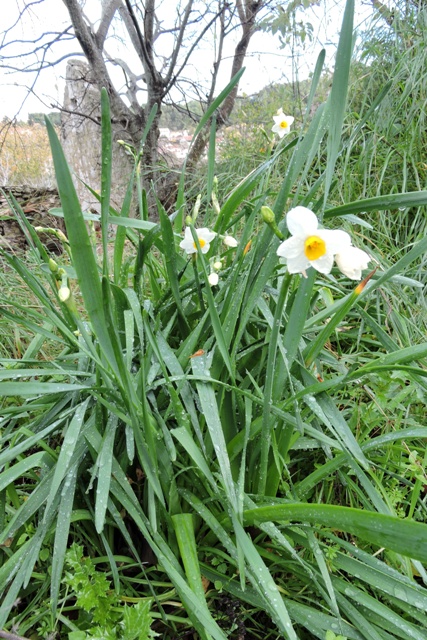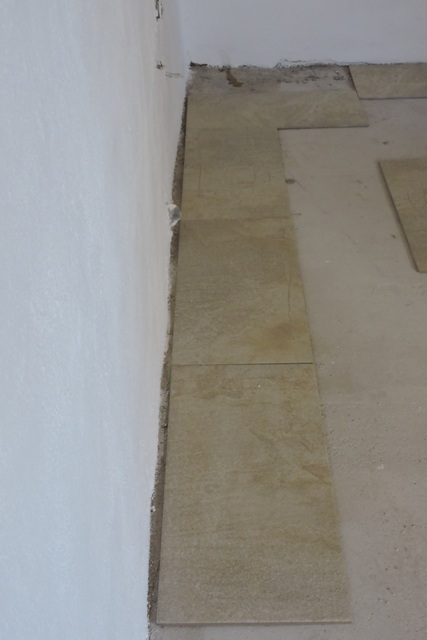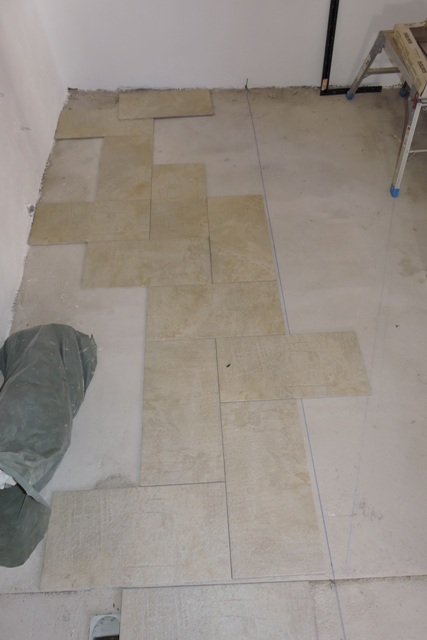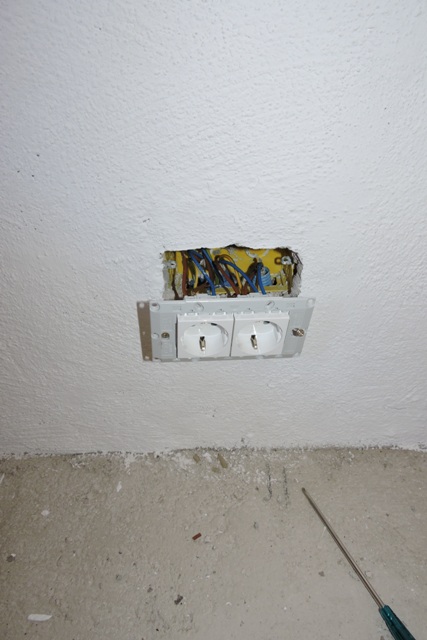My square on the hypotenuse
This week: Unequal quadrilateral; My square on the hypotenuse; 10 men went to mow; Finishing touches;

Pretty much everywhere you look the buds are swelling on twigs and branches. On some they have burst and the first leaves are just beginning to show.

The one exception are my apple and pear trees, which are in the coldest orchard, deliberately so.
Temperate plants need a certain number of winter chilling hours, at a temperature usually above freezing but below +7ºC. This period of being in cool or cold air prepares the plant or tree for blossoming in the spring.
This process is known technically as Vernalisation. The onset of cooler temperatures begins the process of winter dormancy then each plant requires a minimum number of hours in cold air, before it starts back into growth in the spring.
I have deliberately chosen fruit tree varieties which have a very low chilling hours requirement, often less than 100 hours in total, so they are suitable for my climate.
I have some Narcissi which are one of my Springwatch indicator species. Usually they are in flower in January.

This winter however, they have leaves but no flowers.
I suspect that because it was a mild autumn and a warm November and early December, they have not had enough cold days to trigger the bulbs into producing a flower buds.
The plants are still alive, but their strap leaves are smaller than usual and they look a little sclerotic.
So this year I will mark them on my calendar as having no flowers buds or flowers.
Plants which originate in sub-subtropical areas do not have this need. Indeed whilst many can survive a small number of low temperature hours, the more tender varieties will be damaged by long periods of cold and frost.
So far this winter I have not recorded any nights with a below 0ºC temperature. There have been some light radiation frosts though, but not enough to really damage any plants.

With clear and sunny days all this week and equally clear nights, overnight temperatures have fallen and on one morning there was the thinnest film of ice on my water lily containers.
As the sun is higher in the sky every day now and the days lengthen, I really need to prune my apples and pears this week.

Unequal quadrilateral
Now that I have finished painting the walls of the cottage, my attention has turned to the floor.
The room has four sides, three windows a niche and a door. By virtue of having four sides makes it a quadrilateral. However they are somewhat unequal!
When Cvjetko was rendering the walls, I had several conversations with him about the uneven walls. He was apologising for not being able to get things vertical. Apart that is from the new wall at the south end.
There is a dearth of right angle corners too. I explained the old English proverb that “you can’t make a silk purse from a sow’s ear“.
But we have got very close. A new, level, insulated and bone dry floor for example.
This is going to be the pantry and utility room, but even so I have been thinking about the tile pattern. There are many good websites where different designs are explained.
My new tiles are 60 cm x 30 cm and although laying them diagonally would look nice, there is an awful lot of cutting involved in laying diagonals.
Before doing some trials, I decided to set a few lines so I know just how out of true the room is.
I have a really useful blue chalk line to help. It requires a nail in two corners then the line is stretched to the opposing corner and twanged. This leaves a neat, straight blue line visible on the floor.

Once the centre of the room has been established, it is easy to run lines which are at 90 degrees to each other.

Finally a straight edge shows how much the walls run off.

My square on the hypotenuse
What do you remember about your school days?
I remember being told by uncles and aunts on numerous occasions that “Schooldays are the best days of your life”.
Well maybe in their day they were, but for me, I hated school and couldn’t jump ship quickly enough.
My career days have been the best days of my life and were over far too quickly!
Drilling down, what do you remember about being in school – I won’t ask for what reasons?
I remember being the Guinee-pig intake who were experimented on by being the first year to be involved in SMP Maths – the School Maths Project.
Then there was geometry and Logarithm tables. I didn’t understand Logarithm tables at school and I don’t understand them now. I have never, ever used them since I left school.
Geometry on the other hand is something I have used regularly over the years and have used it again this week in my Cottage.
I’ve bought some really nice tiles for the floor of the cottage. They are light in colour with a slight gloss shine to reflect light. They are also slightly rough, so that they have a non-slip surface in a room where there may be moisture present.
The question I was trying to answer with geometry was the pattern. Given as I mentioned previously, the walls are somewhat less than square and parallel, I wanted to make sure that the tiles look nice.
As I’ve already mentioned, my tiles are oblong, 60 cm by 30 cm, so there are various ways that they could be laid on the floor. A herringbone pattern is one, but fundamentally do I lay them lengthwise, crosswise, or diagonally.
Add to this the amount of wastage with different patterns. I don’t have an unlimited supply of tiles, so I wanted to make sure that I use what I have well.
If I laid the tiles diagonally, there would be a lot of wastage and a huge amount of cutting required, so although my preferred option, I dismissed it on the grounds of practicality.
To make a long, narrow room look wider, you need to lay tiles across. If they are laid longitudinally, then the room looks even longer and narrower.
So by a process of elimination I came up with a result. But where do you start?
I used a chalk line across the diagonals between the four corners to find the centre of the room. Then I used my Pythagoras theorem to fix a central line. The old square on the hypotenuse fixed a centre line.

At this point I then did a trial lay of some tiles.
10 men went to mow
Sickles and scythes are popular tools here. I have one at the back of my garden tool shed.
I even found new blades were for sale here – not something you could find in many places these days.

There is a popular English language counting song, “10 men went to mow; went to mow a meadow…” I don’t have a meadow, in fact I’ve never seen a meadow on the island, although some people mow their olive groves.
However I don’t need a degree in applied mathematics to know that ten men will complete the task of mowing the meadow ten times faster than one man, even though he had his dog with him too.
So too with laying floor tiles. Having spent an inordinate amount of time on my hands and knees with squares, tape measures and chalk lines, and experimented with different designs, I was not looking forward to starting to lay the tiles.
This is mainly because it has been cold, windy and the cottage doesn’t have any doors and windows at the moment, which make the place rather draughty.
So when Cvjetko telephoned to say that he had some more spare time and he would be here on Thursday afternoon with his team, to start laying ceramic tiles, I really didn’t object.
With several knowledgeable and experienced craftsmen present, I retired to cut some firewood.
You can have too many people mowing the floor of a small building…

After another afternoon’s work, almost half the floor has been tiled.
I can say with authority that it is almost half, because I can still see the centre of the room mark I prepared earlier.
But like mowing a meadow of indeterminate size, the more professionals you have, the faster the job is done.
Finishing touches
With the tiling under way, I started on connecting the wiring in the cottage.
Some of the small jobs do take a lot of time, but give a great deal of satisfaction when they are finished.
This room does not have a lot of plug sockets, only five, and the two light fittings. However there was still a lot of connecting to do.
The fittings in use here are all modular and can be put into different size mounting frames. This is one of the two-module frames.

My wiring is a ring main, so it runs in a circle. One wire comes into the box in the wall and connects to the first module.
The modules are linked together then the second wire is connected to the second module and the wiring circuit continues.
The first fixing has left the cables exposed.

The protective sleeveing is first removed.

The next job is to trim the wires to the appropriate length and then connect the wiring to the sockets.

The wall boxes are all cleaned out then the face plate is fixed to the wall.

Finally the cover is pressed into place and the socket is finished.

When everything is connected up, I’ll connect the ring main at the consumer unit and turn the power on…
Cat playing with an aeroplane
I always finish work at lunch time on Saturdays. Saturday afternoon’s are “my time”.
I write up the blog, upload the photographs, do the formatting and then tell everyone it’s published.
So this afternoon, with the sun shining, I had a walk up the hill behind my home, with a couple of the felines in front and two behind complaining loudly that I was wasn’t waiting for them.

I found some interesting plants which I will photograph next week and enjoyed the solitude and quiet of the woods.
The felines enjoyed their play time, which reminded me of a video of a big cat playing with an aeroplane…. Enjoy NCG
3 Responses
Andy Robinson
Another interesting blog Norman. I wish we had the same signs of plant life here…its so cold and miserable at the moment and everything is damp and dormant.
As to your wiring…
Brave man…its the only thing I won’t have a go at…..
Lynne
Hello Norman
I think I forgot to wish you
HAPPY NEW YEAR
I am reading your blogs and sometimes feel quite sad that we are no longer there
Things here are still strange owing to
Covid and I am only working two days
A week now.
I cant wait to get February out of the way. Then spring.
Take care.xx
John Bailey
Interesting read Norman. Winter in East Anglia has been mild so far with no snow. Violets are out in flower. With your climate you are fast heading for spring and well ahead of us. Tiling is coming along nicely. Looking good.